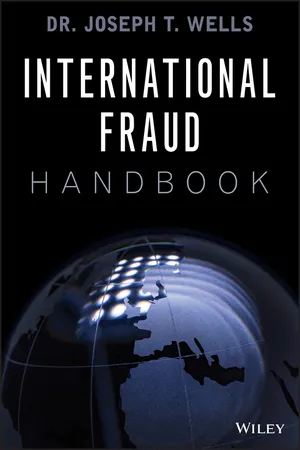
- English
- ePUB (mobile friendly)
- Available on iOS & Android
International Fraud Handbook
About this book
The essential resource for fraud examiners around the globe
The International Fraud Handbook provides comprehensive guidance toward effective anti-fraud measures around the world. Written by the founder and chairman of the Association of Certified Fraud Examiners (ACFE), this book gives examiners a one-stop resource packed with authoritative information on cross-border fraud investigations, examination methodology, risk management, detection, prevention, response, and more, including new statistics from the ACFE 2018 Report to the Nations on Occupational Fraud and Abuse that reveal the prevalence and real-world impact of different types of fraud. Examples and detailed descriptions of the major types of fraud demonstrate the various manifestations examiners may encounter in organizations and show readers how to spot the "red flags" and develop a robust anti-fraud program.
In addition, this book includes jurisdiction-specific information on the anti-fraud environment for more than 35 countries around the globe. These country-focused discussions contributed by local anti-fraud experts provide readers with the information they need when conducting cross-border engagements, including applicable legal and regulatory requirements, the types and sources of information available when investigating fraud, foundational anti-fraud frameworks, cultural considerations, and more.
The rising global economy brings both tremendous opportunity and risks that are becoming increasingly difficult to manage. As a result, many jurisdictions are attempting to strengthen their anti-fraud environments — whether through stricter anti-bribery laws or more stringent risk management guidelines — but a lack of uniformity in legal rules and guidance can be challenging for organizations doing business abroad. This book helps examiners mitigate fraud in their own organizations, while taking the necessary steps to prevent potential legal exposure.
- Understand the different types of fraud, their common elements, and their impacts across an organization
- Conduct a thorough risk assessment and implement effective response and control activities
- Learn the ACFE's standard investigation methodology for domestic and cross-border fraud investigations
- Explore fraud trends and region-specific information for countries on every continent
As levels of risk increase and the risks themselves become more complex, the International Fraud Handbook gives examiners a robust resource for more effective prevention and detection.
Frequently asked questions
- Essential is ideal for learners and professionals who enjoy exploring a wide range of subjects. Access the Essential Library with 800,000+ trusted titles and best-sellers across business, personal growth, and the humanities. Includes unlimited reading time and Standard Read Aloud voice.
- Complete: Perfect for advanced learners and researchers needing full, unrestricted access. Unlock 1.4M+ books across hundreds of subjects, including academic and specialized titles. The Complete Plan also includes advanced features like Premium Read Aloud and Research Assistant.
Please note we cannot support devices running on iOS 13 and Android 7 or earlier. Learn more about using the app.
Information
PART I
CHAPTER 1
Introduction*
WHAT IS FRAUD?
- A material false statement (i.e., a misrepresentation)
- Knowledge that the statement was false when it was uttered (i.e., intent)
- The victim’s reliance on the false statement
- Damages resulting from the victim’s reliance on the false statement
Components of Fraud
- The act
- The concealment
- The conversion
The Act
The Concealment
The Conversion
WHAT FACTORS LEAD TO FRAUD?
The Fraud Triangle

- Pressure
- Perceived opportunity
- Rationalization
Pressure
- Inability to pay one’s bills
- Drug or gambling addiction
- Need to meet earnings forecast to sustain investor confidence
- Need to meet productivity targets at work
- Desire for status symbols, such as a bigger house or nicer car
Opportunity
Table of contents
- Cover
- Title Page
- Copyright
- Dedication
- Preface
- Acknowledgments
- About the ACFE
- PART I
- PART II
- Index
- End User License Agreement